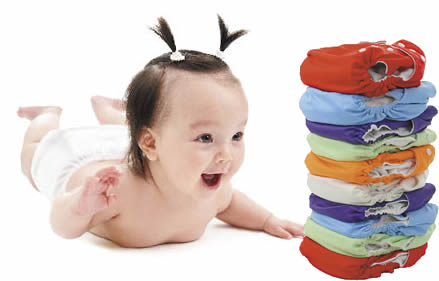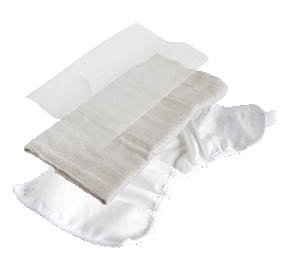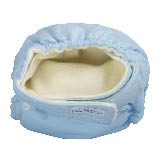
Soft Bottoms
Considering the Options in Cloth Diapers
Story by Meghan Cornelison
When it comes to babies, one thing is for sure: they don’t use the toilet. Those little (or not so little) baby messes have to go somewhere – usually into a diaper. Increasingly, many eco-conscious, or budget-minded parents, choose reusable cloth diapers over disposables. “I think we have a growing cloth diapering community,” says Maria Klein, owner of Birch Tree Baby, an Anchorage-based cloth diaper supply store.
Why choose cloth?
Parents are choosing cloth diapers for a variety of reasons, including how “soft” they are on the environment. Nearly 28 billion disposable diapers fill up our landfills every year, making them the third largest single consumer item in landfills. It is estimated that a disposable diaper takes 250-500 years to decompose.
Parents also appreciate how cloth diapers are “soft” on the bottoms and better for baby’s health. While cloth diapers are made from natural fibers, disposable diapers are made of paper pulp, plastics and “superabsorbent” chemicals. One area of concern are the toxic chemicals present in most brands of disposable diapers, including traces of Dioxin, listed as a carcinogenic chemical by the EPA, and Tributyl-tin (TBT), a toxic pollutant known to cause hormonal problems in humans and animals.
Cloth diapers can be “soft” on the wallet too. The average child will go through 6,000 to 7,000 diapers from birth to age 3. Based on the cost for disposable diapers, that’s $2,000-$3,000 per child. In comparison, you can cloth diaper a child from birth to potty-training anywhere from $400-$1800, depending on the cloth diapering system you choose. The cost upfront may be more, but over the long haul (especially if you have two or more children), it’s cheaper to go cloth.
“A big motivation initially was cost,” says Anchorage mom Chris Jackson. “We looked at the cost of disposables versus reusables and saw that we could save over a thousand dollars. But we also feel really good about not creating all that waste.”
An added bonus: In cloth diapers, babies generally become more aware of their wet diapers, prompting them to potty train earlier – and saving parents even more money in the long run.
Not your grandmother’s cloth diapers
Cloth diapers have come a long way since your grandmother used them. “When we first told people we were thinking about using cloth, many of them looked at us like we were nuts, but these aren’t like the old diapers,” says Jackson. “These aren’t the ones the stork brings babies in,” jokes her husband Mike Jackson. No longer limited to folding and pinning, today’s parents who go with cloth can choose from over half a dozen different types of diapers.
Are you considering cloth diapers, but feeling overwhelmed by the choices and don’t know where to start? By first asking yourself a few questions and then arming yourself with a basic understanding of diaper styles, you’ll find that choosing cloth diapers will be much less daunting.
Ask Yourself:
Budget or convenience? Lara Lotze, co-owner of Blueberry Baby in Fairbanks since 2004, says that when she does diaper consultations, she asks customers to consider whether maximum cost savings or convenience is more important to them. Along those lines, Klein says she asks customers about their lifestyle. “What will be baby’s routine? Are you out and about a lot? Those types of questions,” says Klein.
Who else will change baby? Think about the concerns of everyone involved in baby’s care, including your partner, other family members and care providers. “The biggest thing for us was a combination of cost and what would be accepted at day care (facilities),” says Iris Matthews, an Anchorage mother of two. “We wanted something that would be super easy and accessible for anyone to use.”
Laundry? Caring for cloth diapers is easier than you might think, but your laundry preferences and set-up play a role in your diaper choice, according to Klein. “The type of fiber diapers are made from is important in terms of their care,” says Klein. Parents should be willing to pay attention to their laundry products and process, especially with diapers made from synthetic fabrics, like fleece or micro suede. These fabrics can build-up residues if not washed properly. Natural fibers, such as cotton or hemp tend to be more forgiving in the wash.
If washing cloth diapers is not for you, look into whether a diaper service, which takes care of the laundering process, is available in your area. “It takes the ‘yuck’ factor away and makes it almost as easy as tossing disposables into a pail,” says Theresa Perez, owner of Happy Bottoms Diaper Service in Anchorage.
Diaper Options

Prefolds: If cost savings and easy care are your top priorities, prefolds are the way to go. Klein sells starter setups of prefolds for less than $150, which can be your only diaper costs for the first six to 12 months. Prefolds consist of several layers of natural-fiber fabric that have been sewn together. Despite their name, prefolds do require some simple folding to fit onto a baby. They are pre-folded compared to the truly old-fashioned single-layer flat diapers. Prefolds also need a fastener, such as a product called Snappis or diaper pins, to secure them in place and a cover or wrap to contain wetness. “There is a little bit of a learning curve as far as getting them on,” says Lotze. But, “with a little practice, they can be easy and fun to use,” says Klein. Prefolds are easy to wash and dry and offer great absorbency. “Well-made prefolds are probably one of the most absorbent diapers out there,” says Lotze.
At right: Organic cotton prefold diaper from Bummis

Fitted Diapers: Landing in the middle of the cloth diaper price range, fitted diapers offer added convenience. With their fitted cut and built-in fasteners, such as snaps or aplix (Velcro), they are easier to put on than prefolds. Fitted diapers are made up of absorbent natural-fiber fabric cut to conform to babies’ body shape, with elastic along the edges. “Natural fibers are great because the more you wash them, the more absorbent they become,” says Klein. Like prefolds, you need a protective cover as an outer layer, so they involve a two-step process at changing times. “The fitted diapers are my favorite for the newborn size because of their added protection,” says Lotze. The double layers of elastic in the diaper and cover help contain those huge, explosive blow-outs young babies produce, cutting down on the number of poop-stained onesies in the laundry.
At right: Fitted diaper from Kissaluvs

Pocket Insert Diapers and All-In-Ones: If you know you want an easy, one-step changing process, look at pocket insert diapers or all-in-ones. “They are the closest thing we have to the convenience of a disposable,” says Lotze. These diapers have an attached waterproof outer layer and built-in closures. With pocket diapers, the outer layer and a synthetic-fiber inner layer are sewn together, with one side left open to create a pocket. Parents stuff absorbent inserts into the pocket. Pocket diapers add some time to the laundering process, since the inserts have to be removed and stuffed back in for each wash, but their adjustable absorbency is handy for periods of extended use. “Pocket diapers are great for overnights or long car trips,” says Lotze. “You can add as many or few inserts as you need.” All-in-ones are similar in design, but the absorbent middle is permanently sewn into the diaper. The easy use of pockets and all-in-ones makes them a popular diaper style and a good choice for babies in day care. Their soft synthetic inner layers help wick moisture away from babies’ skin, but you need to be more careful about laundry products for these styles, according to Lotze. “Oil-based products can cause the fleece to repel moisture, rather than wick it,” she says.
At right: Pocket diaper from Happy Heinys

One-Size Diapers: Both pocket diapers and all-in-ones come as one-size diapers, which can be folded and snapped to fit smaller babies, and then let out as baby grows. However, one-sized diapers do not really work well for newborn babies, according to Klein. Both Klein and Lotze say they suggest purchasing a set of small, newborn-sized diapers for the early months, or using prefolds in the beginning, then transitioning to one-sized diapers.
At right: One-size organic cotton all-in-one diaper from bumGenius
If you think you want to use cloth diapers, take the time to talk to experts and other parents to see the diapers in action. Be assured, you will be diapering like a pro and loving your baby’s adorable cloth-covered tush in no time.










